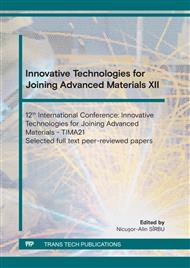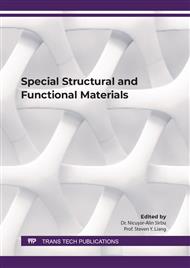[1]
Pistorius P. C. and Burstein G. T. 1992 Metastable pitting corrosion of stainless steel and the transition to stability, Philosophical Transactions of the Royal Society of London. Series A: Physical and Engineering Sciences341531–559 http://doi.org/10.1098/rsta.1992.0114.
DOI: 10.1098/rsta.1992.0114
Google Scholar
[2]
J. A. N. Friend and J. Bennett, J. Chem. Soc. (London), 121, 41 (1922).
Google Scholar
[3]
W. Whitman, R. Russell, C. Welling, and J. Cochrane, Ind. Eng. Chem., 15, 672 (1923).
Google Scholar
[4]
W. Whitman and R. Russell ibid., 17, 4 (1925).
Google Scholar
[5]
T.K. Ross, G.C. Wood, and I.J. Mahmud, The Anodic Behavior of Iron Carbon Alloys in Moving Acid Media, J. Electrochem. Soc., Vol 113, (1966), p.334.
DOI: 10.1149/1.2423957
Google Scholar
[6]
J. Robertson, The mechanism of high temperature aqueous corrosion of stainless steels, Corrosion Science, Volume 32, Issue 4, 1991, Pages 443-465, ISSN 0010-938X, https://doi.org/10.1016/0010-938X(91)90125-9.
DOI: 10.1016/0010-938x(91)90125-9
Google Scholar
[7]
Rosemann, P., Müller, T., Babutzka, M. and Heyn, A. (2015), Influence of microstructure and surface treatment on the corrosion resistance of martensitic stainless steels 1.4116, 1.4034, and 1.4021. Materials and Corrosion, 66: 45-53. https://doi.org/10.1002/maco.201307276.
DOI: 10.1002/maco.201307276
Google Scholar
[8]
Rosemann, P., Kauss, N., Müller, C. and Halle, T. (2015), Influence of solution annealing temperature and cooling medium on microstructure, hardness and corrosion resistance of martensitic stainless steel X46Cr13. Materials and Corrosion, 66: 1068-1076. https://doi.org/10.1002/maco.201408081.
DOI: 10.1002/maco.201408081
Google Scholar
[9]
DIN EN 10088-3 Standard.
Google Scholar
[10]
H M Christen and G Eres 2008 J. Phys.: Condens. Matter 20 264005.
Google Scholar
[11]
S. Amoruso, 6 - Plume characterization in pulsed laser deposition of metal oxide thin films, Editor(s): Nini Pryds, Vincenzo Esposito, In Metal Oxides, Metal Oxide-Based Thin Film Structures, Elsevier, 2018, Pages 133-160, ISBN 9780128111666.
DOI: 10.1016/b978-0-12-811166-6.00006-6
Google Scholar
[12]
Krebs HU. et al. () Pulsed Laser Deposition (PLD) -- A Versatile Thin Film Technique. In: Kramer B. (eds) Advances in Solid State Physics. Advances in Solid State Physics, vol 43. Springer, Berlin, Heidelberg. https://doi.org/10.1007/978-3-540-44838-9_36.
DOI: 10.1007/978-3-540-44838-9_36
Google Scholar
[13]
D. M. Bubb, P. K. Wu and J. S. Horwitz, J. H. Callahan, M. Galicia, A. Vertes, R. A. McGill, E. J. Houser, B. R. Ringeisen, and D. B. Chrisey, The effect of the matrix on film properties in matrix-assisted pulsed laser evaporation,, Journal of Applied Physics 91, 2055-2058 (2002) https://doi.org/10.1063/1.1427138.
DOI: 10.1063/1.1427138
Google Scholar
[14]
A. Piqué, R.A. McGill, D.B. Chrisey, D. Leonhardt, T.E. Mslna, B.J. Spargo, J.H. Callahan, R.W. Vachet, R. Chung, M.A. Bucaro, Growth of organic thin films by the matrix assisted pulsed laser evaporation (MAPLE) technique, Thin Solid Films, Volumes 355–356, 1999, Pages 536-541, ISSN 0040-6090.
DOI: 10.1016/s0257-8972(99)00376-x
Google Scholar
[15]
Piqué, A. The Matrix-Assisted Pulsed Laser Evaporation (MAPLE) process: origins and future directions. Appl. Phys. A 105, 517–528 (2011). https://doi.org/10.1007/s00339-011-6594-7.
DOI: 10.1007/s00339-011-6594-7
Google Scholar



